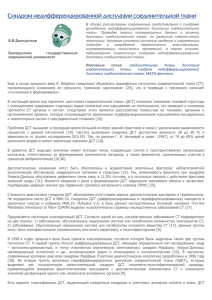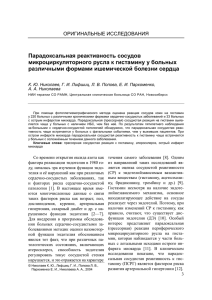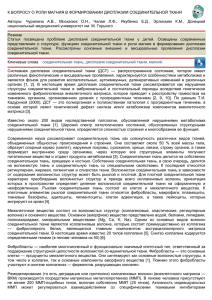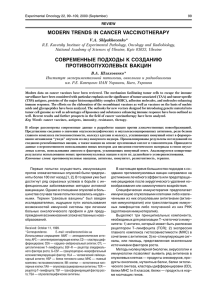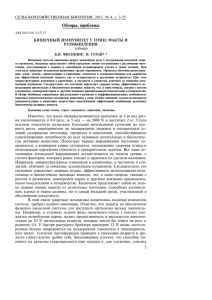( ) -
реклама
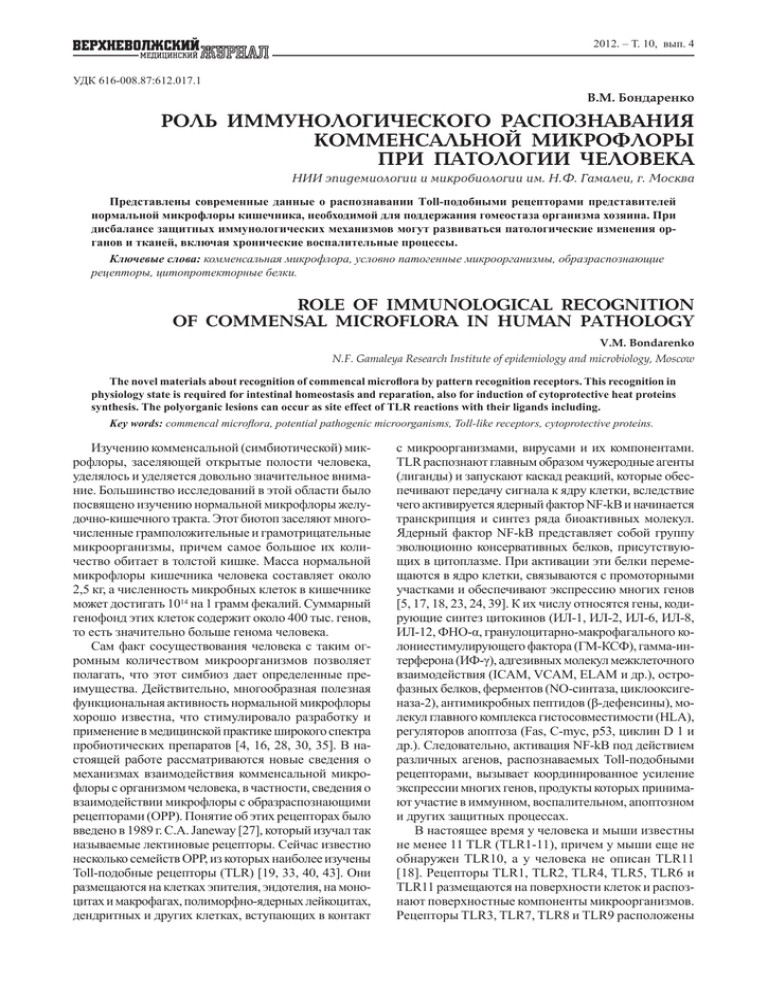
2012. – . 10, .4 616-008.87:612.017.1 . . РОЛЬ ИММУНОЛОГИЧЕСКОГО РАСПОЗНАВАНИЯ КОММЕНСАЛЬНОЙ МИКРОФЛОРЫ ПРИ ПАТОЛОГИИ ЧЕЛОВЕКА НИИ эпидемиологии и микробиологии им. Н.Ф. Гамалеи, г. Москва oll, . - , . : , , , . ROLE OF IMMUNOLOGICAL RECOGNITION OF COMMENSAL MICROFLORA IN HUMAN PATHOLOGY V.M. Bondarenko N.F. Gamaleya Research Institute of epidemiology and microbiology, Moscow The novel materials about recognition of commencal microflora by pattern recognition receptors. This recognition in physiology state is required for intestinal homeostasis and reparation, also for induction of cytoprotective heat proteins synthesis. The polyorganic lesions can occur as site effect of TLR reactions with their ligands including. Key words: commencal microflora, potential pathogenic microorganisms, Toll-like receptors, cytoprotective proteins. ( ) , , - , TLR ( . ) , - . , - - . NF-kB . NF-kB , - , . - . , 2,5 , 1014 1 . 400 [5, 17, 18, 23, 24, 39]. . , . , -1, -2, -6, -8, ( ), - - ( -12, - , ( , - ), (ICAM, VCAM, ELAM , (NO, ( - . , -2), .), , [4, 16, 28, 30, 35]. - .). , , , (Fas, C-myc, p53, NF-kB Toll- , , , - , ( ). 1989 . . . Janeway [27], . , , . , Toll- ), (HLA), D1 (TLR) [19, 33, 40, 43]. , , , , [18]. TLR11 11 TLR (TLR1-11), TLR10, TLR11 TLR1, TLR2, TLR4, TLR5, TLR6 . TLR3, TLR7, TLR8 TLR9 2012. – . 10, . NOD2, [19]. TLR - - MD-2, MyD88 Toll- [37]. . TLR4 [5, 21, 33]. . - TLR4 TLR2 , ( ) LBP (LPS binding protein), CD14 MD-2. TLR4, TLR2 MyD88, TLR4. . MD-2, TLR1 TLR4 TLR2, TLR2 TLR6. .4 , MyD88, TLR1 , TLR6 , TLR2, TLR2 . - . , TLR4 TLR2, CD14 TLR4 -1. -1 TLR4 CD36. , . , MyD88. , - MyD88 , TLR , , , . , ( - , . ) , , , . , - Toll, , . , [5, 17, 18, 28, 33]. , , . . , TLR, , TLR, [14, 15]. TLR . , TLR : 1) 2) , , . , . D. Rachmilevitz et al. [37]. VSL-3 , . [16] - - , TLR, . . , , TLR . S. Rakoff- MyD88 TLR2, TLR4 TLR9. , VSL-3, , E. oli E. oli - , . , - , Wahoum et al. [37], , Toll- . , , . - 2012. – . 10, . - . , TLR2 .4 TLR4, [8, 9]. , . TLR9 . , , Toll- , TLR9. , , , [23, 33]. , - [33]. - , , [13]. - - , TLR. [29]. , TLR4, - tlr4, Toll- , [35, 40]. , - , , , - , [26]. [28, 32, 35]. , - - , , , . TLR4 , - , . . - , , . , , , TLR4. , - . - , - . TLR4, [5, 15, 29]. TLR2, - , . Fc- , - [13]. - , , , , [22, 23, 34]. - [5, 42]. , , TLR4 TLR2/6 , / - , , , , , , NF- , [11, 22]. , . , , . - TLR2 , , , , . - [23, 45]. . . . [11] , . , - , Toll- - 2012. – . 10, , - ( , , .), , . , , Toll- - . , [3, 7–9]. TLR, , , , , - - [41]. . , - , . TollTLR4 , 60, 70. , TLR2 - [44]. [44]. [44]. 70 , [38]. TLR2, . , - Toll- . MyD88, TLR [37]. , - . , , Toll- . [14]. - , , Toll- . - , - , . . . 1. . / References ., . ., . . .4 . // . . – 2010. – 11 (4). – . 310–313. Anisimova N.Ju., Gromova E.G., Kuznecova L.S. i dr. Soderzhanie bakterial’nogo jendotoksina i citokinov v krovi onkologicheskih bol’nyh s posleoperacionnymi oslozhnenijami // Allergol. immunol. – 2010. – 11 (4). – S. 310–313. 2. . ., . . // .– 2010. – 4. – . 215–219. Behalo V.A., Bondarenko V.M. Immunologicheskie i molekuljarno-geneticheskie osnovy patogeneza hronicheskih vospalitel’nyh zabolevanij kishechnika // Immunologija. – 2010. – 4. – S. 215–219. 3. . . // . – 2007. – 1. – . 27–31. Bondarenko V.M. Patogeneticheskaja rol’ narushennoj mikrobioty kishechnika v poliorgannoj patologii piwevaritel’nogo trakta cheloveka // Donozologija. – 2007. – 1. – S. 27–31. 4. . . // .– 2010. – 1. – . 31–34. Bondarenko V.M. Molekuljarno-kletochnye mehanizmy terapevticheskogo dejstvija probiotikov // BIOpreparaty. – 2010. – 1. – S. 31–34. 5. . ., . . Toll// . – 2009. – 5. – . 317–320. Bondarenko V.M., Lihoded V.G. Vzaimodejstvie kishechnoj mikroflory s Toll-podobnymi receptorami v norme i patologii // Immunologija. – 2009. – 5. – S. 317–320. 6. . ., . . : . – .: , 2007. – 304 . Bondarenko V.M., Maculevich T.V. Disbakterioz kishechnika kak kliniko-laboratornyj sindrom: sovremennoe sostojanie problemy. – M.: GJeOTAR-Media, 2007. – 304 s. 7. . ., . . // . . .– 2011. – 4. – . 8–14. Bondarenko V.M., Rjabichenko E.V. Rol’ nespecificheskoj infekcii v razvitii ostroj i hronicheskoj vospalitel’noj patologii nervnoj sistemy // Jepidemiol. inf. bolezni. – 2011. – 4. – S. 8–14. 8. . ., . . . – 2004. – 3 (4). – . 10–13. Voskan’janc A.N., Nagornev V.A. Citokiny i vospalenie. – 2004. – 3 (4). – S. 10–13. 9. . ., . ., . . . – // . . – 2010. – 82 (2). – . 84–91. Vorob’eva E.N., Shumaher G.I., Horeva M.A. i dr. Disfunkcija jendotelija – kljuchevoe zveno v patogeneze ateroskleroza // Rossijskij kardiol. zhurnal. – 2010. – 82 (2). – S. 84–91. 10. . . : . . // . .– 2008. – 5. – . 10–15. Koval’chuk L.V. Uchenie o vospalenii v svete novyh dannyh: razvitie idej I.I. Mechnikova // Zhurn. mikrobiol. – 2008. – 5. – S. 10–15. 11. . ., . ., . . . // . . – 2008. – 4. – . 64–68. Koval’chuk L.V., Horeva M.V., Varivoda A.S. i dr. Rol’ receptorov vrozhdennogo immuniteta v razvitii ostrogo infarkta miokarda // Zhurn. mikrobiol. – 2008. – 4. – S. 64–68. 2012. – . 10, 12. . ., ( . . - ) // . . – 2006. – 2. – . 207–313. Lebedev K.A., Ponjakina I.D. Immunofiziologija jendogennyh infekcij (opredeljajuwaja rol’ obrazrazpoznajuwih receptorov) // Allergol. immunol. – 2006. – 2. – S. 207–313. 13. . ., . . . – .: , 2007. – 215 . Lihoded V.G., Bondarenko V.M. Antijendotoksinovyj immunitet v reguljacii chislennosti jesherihioznoj mikroflory kishechnika. – M.: Medicina, 2007. – 215 s. 14. . ., . ., . . . // . . .– 2010. – 2. – . 92–96. Lihoded V.G., Bondarenko V.M., Gincburg A.L. Jekzogennye i jendogennye faktory v patogeneze ateroskleroza. Receptornaja teorija aterogeneza // Ros. kardiol. zhurnal. – 2010. – 2. – S. 92–96. 15. . ., . ., . ., . . // . . – 1999. – 3. – . 67–70. Lykova E.A., Bondarenko V.M., Vorob’ev A.A., Sudzhan E.V. Bakterial’naja jendotoksinemija u detej s disbiozom kishechnika // Zhurn. mikromiol. – 1999. – 3. – S. 67–70. 16. . ., . . // . Consilium Medicum. – 2009. – 2. – . 67–70. Parfenov A.I., Bondarenko V.M. Reguljacija sootnoshenija mezhdu normal’noj i patologicheskoj mikrofloroj kishechnika // Gastrojenterologija. Prilozhenie Consilium Medicum. – 2009. – 2. – S. 67–70. 17. . . ( ) // . – 2011. – 1 (3). – . 199–206. Frejdlin I.S. Vzaimosvjazi vrozhdennogo i priobretennogo immuniteta pri infekcijah (revizija klassicheskih dogm) // Infekcija i immunitet. – 2011. – 1 (3). – S. 199–206. 18. . ., . ., . . // . – 2009. – 1. – . 66–76. Haitov R.M., Pawenkov M.V., Pinegin B.V. Rol’ patternraspoznajuwih receptorov vo vrozhdennom i adaptivnom immunitete // Immunologija. – 2009. – 1. – S. 66–76. 19. Akira S. Toll-like receptor signaling // Nat. Rev. Immunol. – 2004. – 4. – P. 499–511. 20. Ando T., Brown R.F., Berg R.D., Dunn A.J. Bacterial translocation can increase plasma corticosterone and brain catecholamine and indolamine metabolism // Am. J. Phisiol. – 2000. – Vol. 279 (6). – R2164–R2172. 21. Armant M.A., Matthew E.J. Toll-like receptors: a family pattern-recognition receptors in mammals // G nome Biol. – 2002. – Vol. 3 (1). – P. 3011–3020. 22. Aukrust P., Gullestad L., Ueland T. et al. Inflammatory and anti-inflammatory cytokines in chronic heartfailure potential therapeutic implications // Annad. Med. – 2005. – Vol. 37. – P. 74–85. 23. Boyd J.H., Mathur S., Wang T. et al. Toll-like receptor stimulator in cardiomyocytes desreased contractility and initiates an NF-kB dependent inflammatory response // Cardiovasc. Res. – 2006. – Vol. 73 (3). – P. 384–393. 24. Chen F., Castranova V., Shi X., Demers L.M. New insights into the role of nuclear factor-kappa B, a ubiquitous transcription factor in the initiation of diseases // Clin. Chem. – 1999. – Vol. 45. – P. 7–17. 25. Cohen N., Morriset J., Emilie D. Induction of tolerance by Porphyromonas gingivalis on APCs // J. Dent. Res. – 2004. – Vol. 83 (5). – P. 420–433. 26. Erridge C., Stewart J., Poxton I.R. Monocytes heterozygous for the Asp299Gly and Thr399Ile mutations in the Toll-like receptor 4 gene show no deficit lipopolysaccharide signaling // J. Exp. Med. – 2003. – Vol. 197. – P. 1787–1791. .4 27. Janeway C.A. Approaching the asymptote? Evolution and revolution in immunology // Cold Spring Harbor Symposium Quant Biology. – 1989. – Vol. 54. – P. 1–13. 28. Kelly D., Conway S., Amirov R. Commensal gut bacteria: mechanism of immune modulation // Trends Immunol. – 2005. – Vol. 26 (6). – P. 326–333. 29. Lan J.G., Cruickhank S.M., Singh J.C. et al. Different cytokine response of primary colonic epithelial cells to commensal bacteria // World J. Gastroenterol. – 2005. – Vol. 11 (22). – P. 3375–3384. 30. Leebeer S., Vanderleyden J. De Keersmaecher S.J. Genes and molecules of Lactobacilli supporting probiotic action // Microbiol. Mol. Biol. Rev. – 2008. – Vol. 72 (4). – P. 728–764. 31. Mayer M. Endothelial cytotoxicity mediated by serum antibodies to heat shock proteins of Escherichia coli and Chlamydia pneumonia: immune reactions to heat shock proteins as apossible link between infection and atherosclerosis // Circulation. – 1999. – Vol. 99 (12). – P. 1560–1566. 32. Melmed G., Thomas L.S., Lee N. et al. Human intestinal epithelial cells are broadly unresponsive to Toll-like receptor 2-dependent bacterial ligands: implications for host-microbial interactions in the gut // J. Immunol. – 2003. – Vol. 170 (3). – P. 1405–1415. 33. Miyake K. Innate immune sensing of pathogens and danger signals by cell surface Toll-like receptors // Sem. Immunol. – 2007. – Vol. 19. – P. 3–10. 34. Ott S.J., El. Mokharty N.E., Musfeldt M. et al. Detection of diverse bacterial signatures in atherosclerotic lesion of patient with coronary heart disease // Circulation. – 2006. – Vol. 113. – P. 929–937. 35. Perdigon G., Galdeano C.M., Valdez J.C. et al. Interaction of lactic acid bacteria with gut immune system // Eur. J. Clin. Nutr. – 2002. – Vol. 56 (Suppl. 4). – P. 21–26. 36. Rachmilevitz D., Katakura K., Karmeli F. et al. Toll-like receptor 9 signaling mediates the anti-inflammatory effect of probiotics murine experimental colitis // Gastroenterol. – 2004. – Vol. 126 (2). – P. 520–528. 37. Rakoff-Wahoum S., Paglino J., Varzaneh E.F. et al. Recognition of commensal microflora by toll-like receptorsis recquired for intestinal homeostasis // Cell. – 2004. – Vol. 118 (2). – P. 229–241. 38. Satoh M., Shimoda Y., Akatsu T. et al. Elevated circulating levels of heat shock protein 70 are related to systemic inflammation reaction through monocyte Toll signal in patients with heat failure after acute myocardial infarction // Eur. Soc. Cardiol. – 2006. – Vol. 8. – P. 810–815. 39. Tak P.P., Firestein G.S. NF-kB: a key role in inflammatory diseases // J. Clin. Invest. – 2001. – Vol. 107 (1). – P. 7–11. 40. Vinderola C.G., Matar C., Perdigon G. Role of intestinal epithelial cells in immune effects mediated by gram-positive probiotic bacteria: involvement of Toll-like receptors // Clin. Diagn. Lab. Immunol. – 2005. – Vol. 12 (9). – P. 1075–1084. 41. Wallin R.P., Lundquist A., More S.H. et al. Heat-shock proteins as activators of innate immune system // Trends Immunol. – 2002. – Vol. 23. – P. 130–135. 42. Wiederman C.J., Kiechl S., Dunzendorfer S. et al. Endotoxemia and atherosclerosis // J. Endotox. Res. – 2000. – Vol. 6 (2). – P. 86–89. 43. Underhill D.M. Toll-like receptors and microbes take aim at each other // Curr. Opin. Immunol. – 2004. – Vol. 16. – P. 483–487. 44. Xu Q., Willet J., Marosi M. et al. Association of serum antibodies to heat-shock protein 65 with atherosclerosis // Lancet. – 1993. – Vol. 341 (8840). – P. 255–259. ( ) – . . ., , . E-mail: brm@gamaleya.org. . . .
